UNCC300: Opinion Editorial on Fast Food and the Common Good
VerifiedAdded on 2022/12/28
|6
|1245
|47
Essay
AI Summary
This opinion editorial examines the detrimental effects of the global fast food market on public health, focusing on the challenges it poses to realizing the aspirations of the common good. It highlights how the availability of ultra-processed foods and aggressive marketing strategies contribute to increased body weight, the obesity epidemic, and chronic diseases. The editorial discusses the role of fast food advertising, which often prioritizes symbolic values and lifestyle associations over nutritional information, leading to high consumption rates, particularly among children. It cites evidence showing the impact of junk food marketing on obesity rates and the adverse effects on health outcomes, including the psychological distress and stigma associated with obesity. The editorial emphasizes the need for education and intervention to mitigate the effects of junk food advertising and address related issues like stigma and absenteeism. The conclusion stresses the need for education to high-risk groups to minimize the impact of fast food advertising on food choices, weight gain and improve the common good.
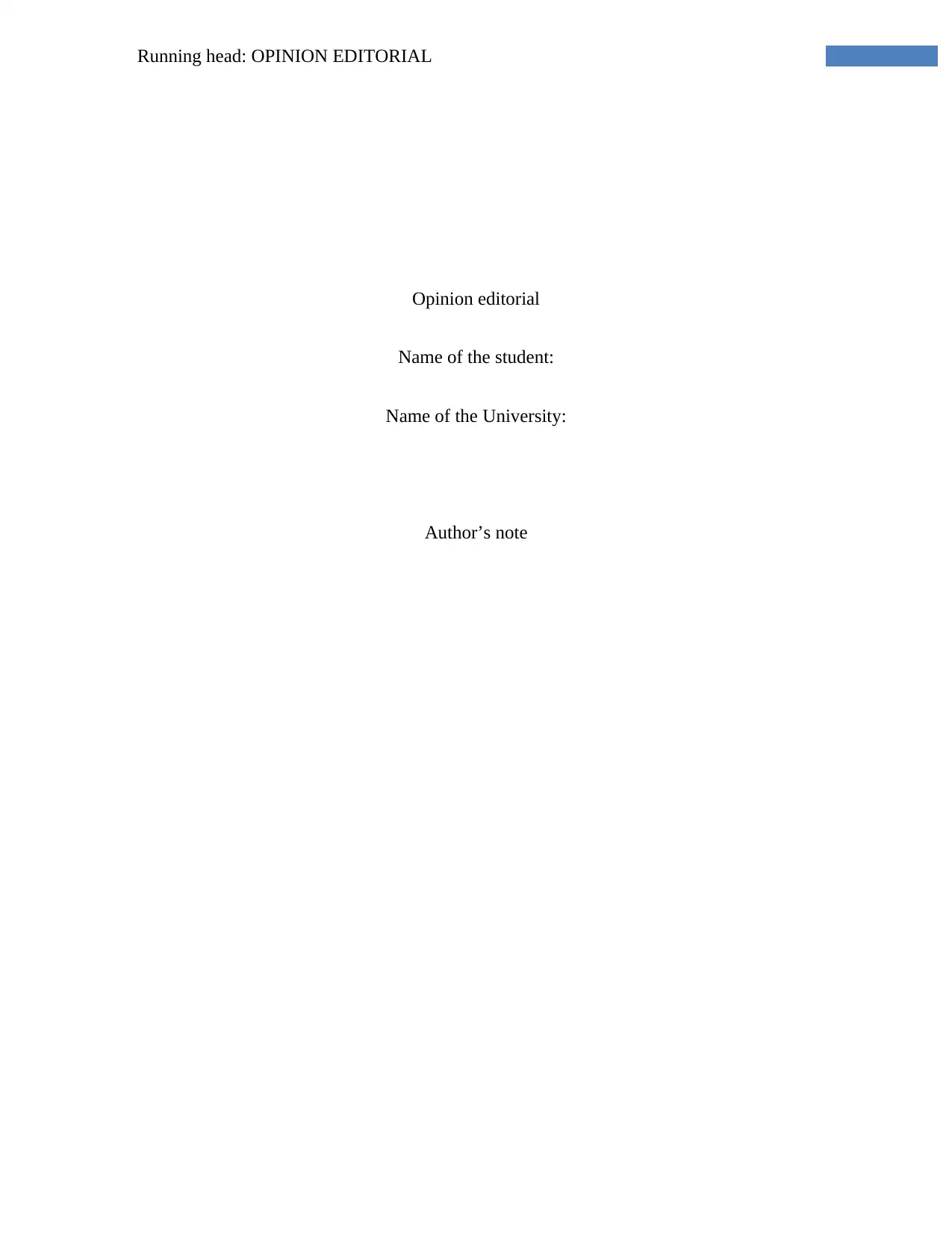
Running head: OPINION EDITORIAL
Opinion editorial
Name of the student:
Name of the University:
Author’s note
Opinion editorial
Name of the student:
Name of the University:
Author’s note
Paraphrase This Document
Need a fresh take? Get an instant paraphrase of this document with our AI Paraphraser
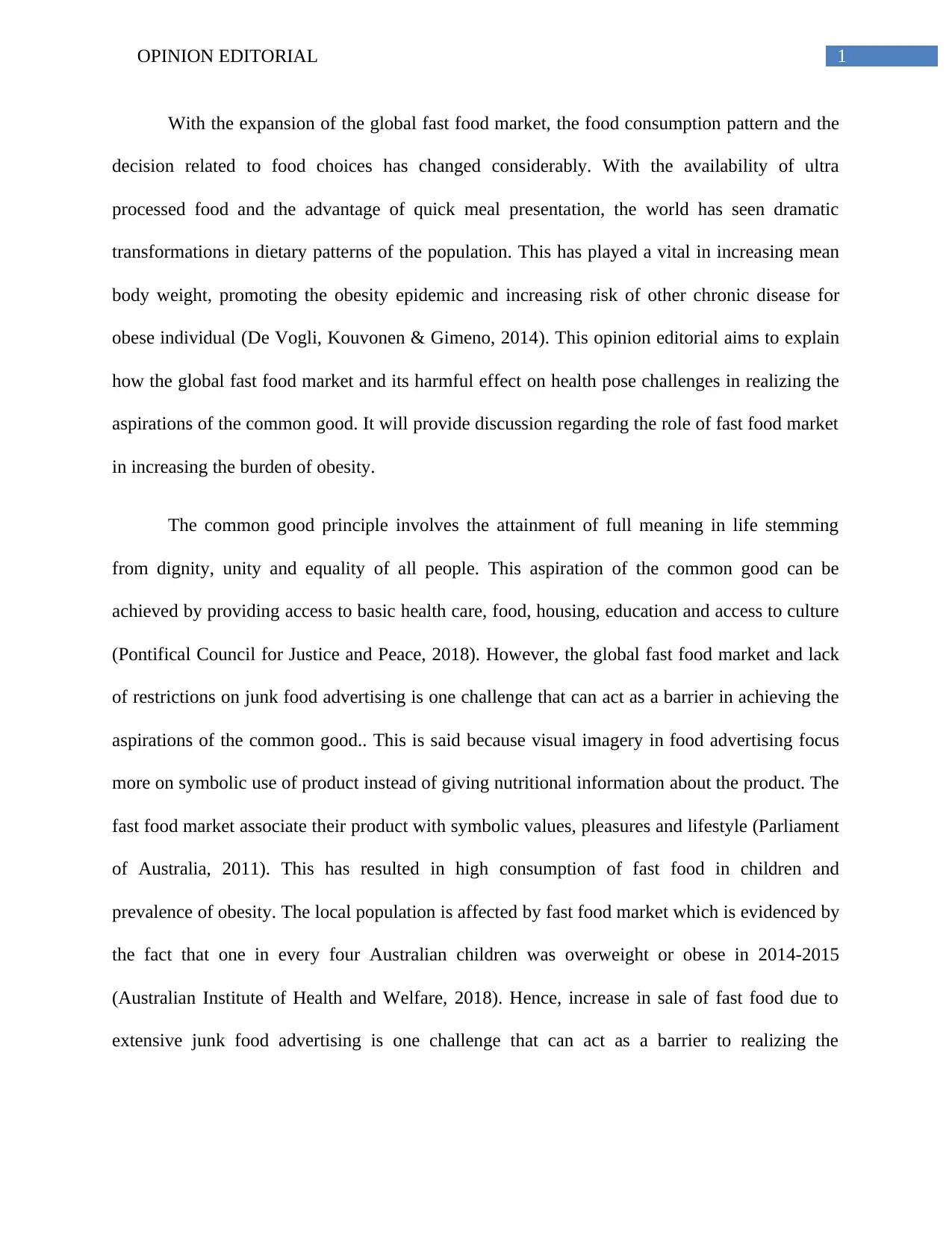
1OPINION EDITORIAL
With the expansion of the global fast food market, the food consumption pattern and the
decision related to food choices has changed considerably. With the availability of ultra
processed food and the advantage of quick meal presentation, the world has seen dramatic
transformations in dietary patterns of the population. This has played a vital in increasing mean
body weight, promoting the obesity epidemic and increasing risk of other chronic disease for
obese individual (De Vogli, Kouvonen & Gimeno, 2014). This opinion editorial aims to explain
how the global fast food market and its harmful effect on health pose challenges in realizing the
aspirations of the common good. It will provide discussion regarding the role of fast food market
in increasing the burden of obesity.
The common good principle involves the attainment of full meaning in life stemming
from dignity, unity and equality of all people. This aspiration of the common good can be
achieved by providing access to basic health care, food, housing, education and access to culture
(Pontifical Council for Justice and Peace, 2018). However, the global fast food market and lack
of restrictions on junk food advertising is one challenge that can act as a barrier in achieving the
aspirations of the common good.. This is said because visual imagery in food advertising focus
more on symbolic use of product instead of giving nutritional information about the product. The
fast food market associate their product with symbolic values, pleasures and lifestyle (Parliament
of Australia, 2011). This has resulted in high consumption of fast food in children and
prevalence of obesity. The local population is affected by fast food market which is evidenced by
the fact that one in every four Australian children was overweight or obese in 2014-2015
(Australian Institute of Health and Welfare, 2018). Hence, increase in sale of fast food due to
extensive junk food advertising is one challenge that can act as a barrier to realizing the
With the expansion of the global fast food market, the food consumption pattern and the
decision related to food choices has changed considerably. With the availability of ultra
processed food and the advantage of quick meal presentation, the world has seen dramatic
transformations in dietary patterns of the population. This has played a vital in increasing mean
body weight, promoting the obesity epidemic and increasing risk of other chronic disease for
obese individual (De Vogli, Kouvonen & Gimeno, 2014). This opinion editorial aims to explain
how the global fast food market and its harmful effect on health pose challenges in realizing the
aspirations of the common good. It will provide discussion regarding the role of fast food market
in increasing the burden of obesity.
The common good principle involves the attainment of full meaning in life stemming
from dignity, unity and equality of all people. This aspiration of the common good can be
achieved by providing access to basic health care, food, housing, education and access to culture
(Pontifical Council for Justice and Peace, 2018). However, the global fast food market and lack
of restrictions on junk food advertising is one challenge that can act as a barrier in achieving the
aspirations of the common good.. This is said because visual imagery in food advertising focus
more on symbolic use of product instead of giving nutritional information about the product. The
fast food market associate their product with symbolic values, pleasures and lifestyle (Parliament
of Australia, 2011). This has resulted in high consumption of fast food in children and
prevalence of obesity. The local population is affected by fast food market which is evidenced by
the fact that one in every four Australian children was overweight or obese in 2014-2015
(Australian Institute of Health and Welfare, 2018). Hence, increase in sale of fast food due to
extensive junk food advertising is one challenge that can act as a barrier to realizing the
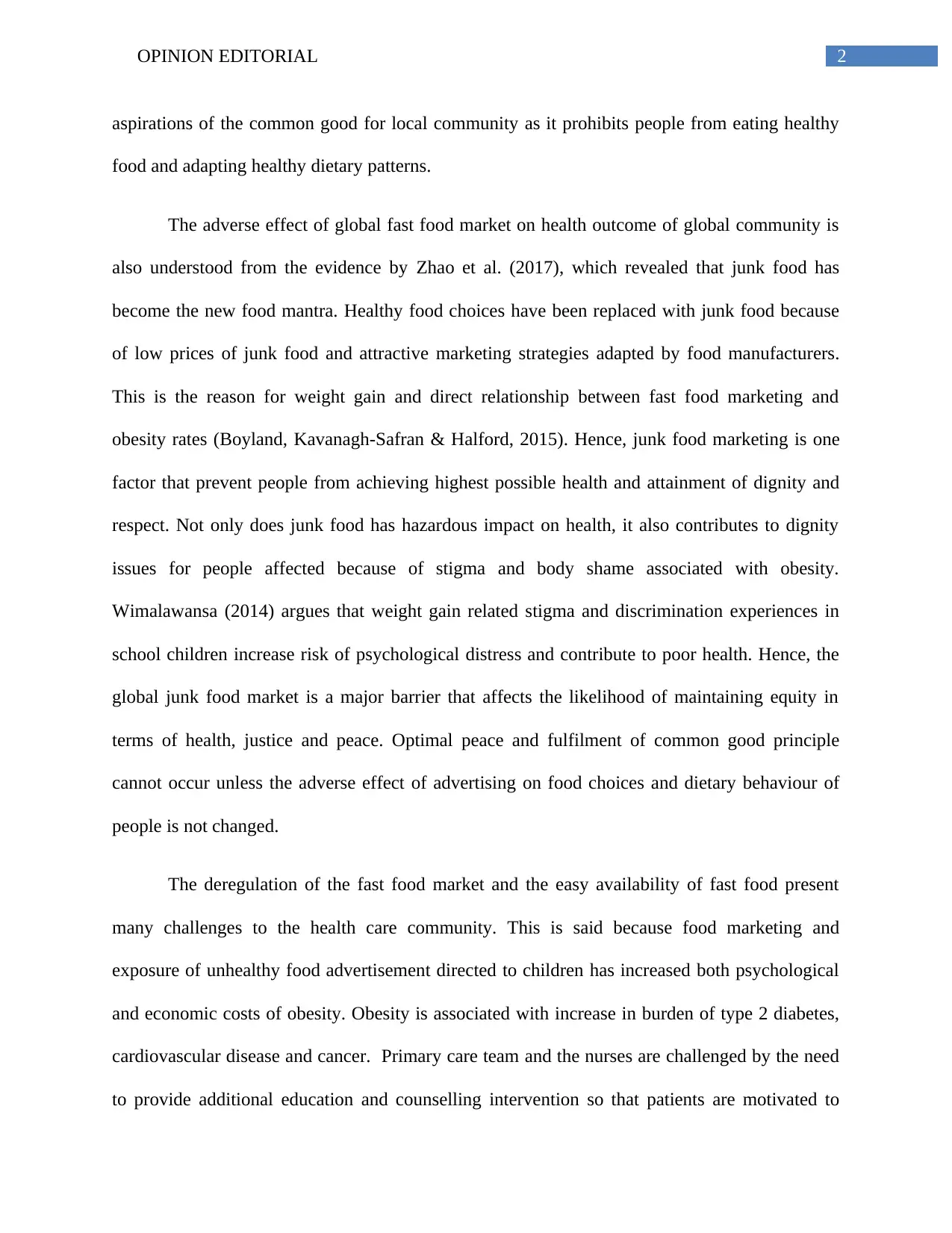
2OPINION EDITORIAL
aspirations of the common good for local community as it prohibits people from eating healthy
food and adapting healthy dietary patterns.
The adverse effect of global fast food market on health outcome of global community is
also understood from the evidence by Zhao et al. (2017), which revealed that junk food has
become the new food mantra. Healthy food choices have been replaced with junk food because
of low prices of junk food and attractive marketing strategies adapted by food manufacturers.
This is the reason for weight gain and direct relationship between fast food marketing and
obesity rates (Boyland, Kavanagh-Safran & Halford, 2015). Hence, junk food marketing is one
factor that prevent people from achieving highest possible health and attainment of dignity and
respect. Not only does junk food has hazardous impact on health, it also contributes to dignity
issues for people affected because of stigma and body shame associated with obesity.
Wimalawansa (2014) argues that weight gain related stigma and discrimination experiences in
school children increase risk of psychological distress and contribute to poor health. Hence, the
global junk food market is a major barrier that affects the likelihood of maintaining equity in
terms of health, justice and peace. Optimal peace and fulfilment of common good principle
cannot occur unless the adverse effect of advertising on food choices and dietary behaviour of
people is not changed.
The deregulation of the fast food market and the easy availability of fast food present
many challenges to the health care community. This is said because food marketing and
exposure of unhealthy food advertisement directed to children has increased both psychological
and economic costs of obesity. Obesity is associated with increase in burden of type 2 diabetes,
cardiovascular disease and cancer. Primary care team and the nurses are challenged by the need
to provide additional education and counselling intervention so that patients are motivated to
aspirations of the common good for local community as it prohibits people from eating healthy
food and adapting healthy dietary patterns.
The adverse effect of global fast food market on health outcome of global community is
also understood from the evidence by Zhao et al. (2017), which revealed that junk food has
become the new food mantra. Healthy food choices have been replaced with junk food because
of low prices of junk food and attractive marketing strategies adapted by food manufacturers.
This is the reason for weight gain and direct relationship between fast food marketing and
obesity rates (Boyland, Kavanagh-Safran & Halford, 2015). Hence, junk food marketing is one
factor that prevent people from achieving highest possible health and attainment of dignity and
respect. Not only does junk food has hazardous impact on health, it also contributes to dignity
issues for people affected because of stigma and body shame associated with obesity.
Wimalawansa (2014) argues that weight gain related stigma and discrimination experiences in
school children increase risk of psychological distress and contribute to poor health. Hence, the
global junk food market is a major barrier that affects the likelihood of maintaining equity in
terms of health, justice and peace. Optimal peace and fulfilment of common good principle
cannot occur unless the adverse effect of advertising on food choices and dietary behaviour of
people is not changed.
The deregulation of the fast food market and the easy availability of fast food present
many challenges to the health care community. This is said because food marketing and
exposure of unhealthy food advertisement directed to children has increased both psychological
and economic costs of obesity. Obesity is associated with increase in burden of type 2 diabetes,
cardiovascular disease and cancer. Primary care team and the nurses are challenged by the need
to provide additional education and counselling intervention so that patients are motivated to
⊘ This is a preview!⊘
Do you want full access?
Subscribe today to unlock all pages.

Trusted by 1+ million students worldwide
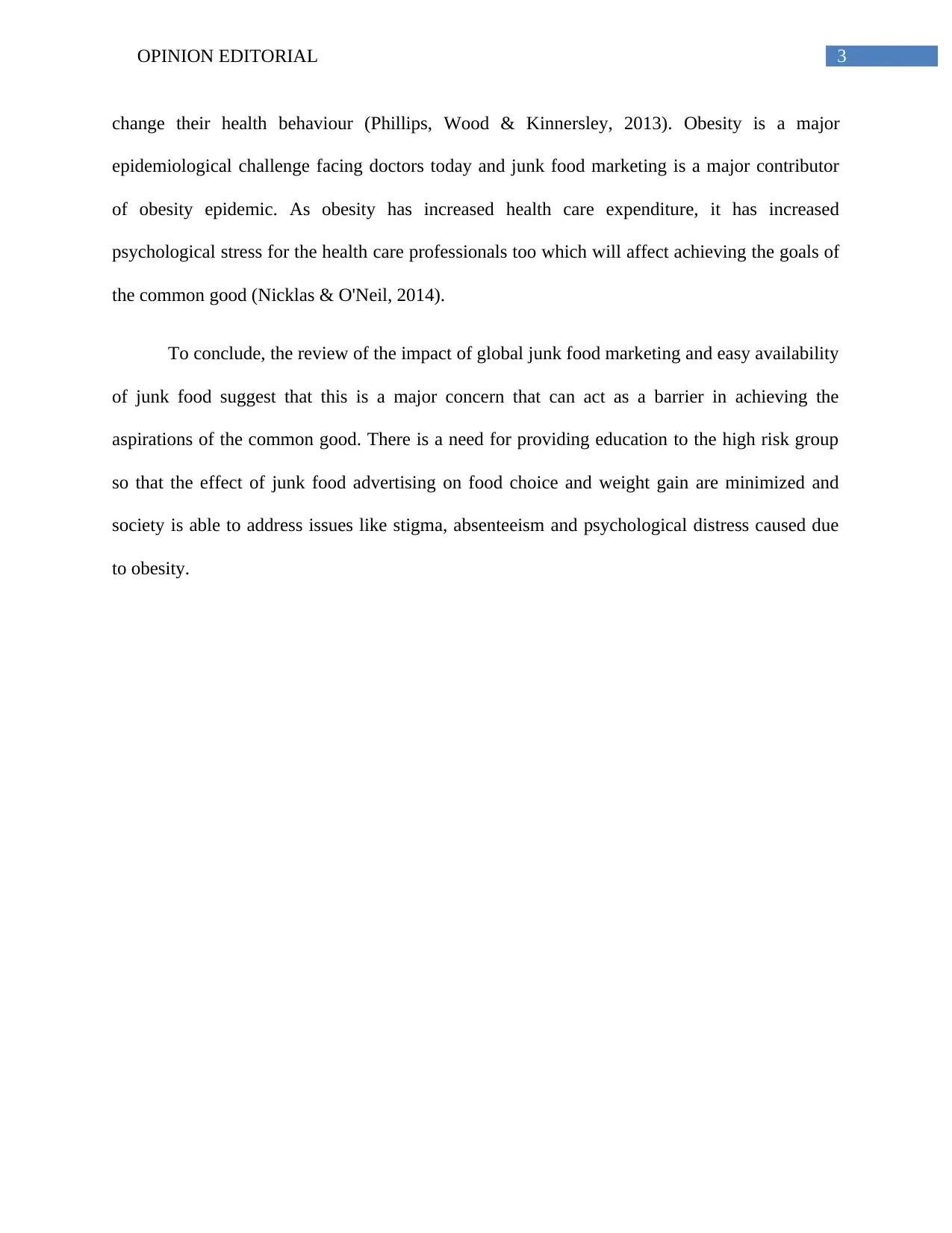
3OPINION EDITORIAL
change their health behaviour (Phillips, Wood & Kinnersley, 2013). Obesity is a major
epidemiological challenge facing doctors today and junk food marketing is a major contributor
of obesity epidemic. As obesity has increased health care expenditure, it has increased
psychological stress for the health care professionals too which will affect achieving the goals of
the common good (Nicklas & O'Neil, 2014).
To conclude, the review of the impact of global junk food marketing and easy availability
of junk food suggest that this is a major concern that can act as a barrier in achieving the
aspirations of the common good. There is a need for providing education to the high risk group
so that the effect of junk food advertising on food choice and weight gain are minimized and
society is able to address issues like stigma, absenteeism and psychological distress caused due
to obesity.
change their health behaviour (Phillips, Wood & Kinnersley, 2013). Obesity is a major
epidemiological challenge facing doctors today and junk food marketing is a major contributor
of obesity epidemic. As obesity has increased health care expenditure, it has increased
psychological stress for the health care professionals too which will affect achieving the goals of
the common good (Nicklas & O'Neil, 2014).
To conclude, the review of the impact of global junk food marketing and easy availability
of junk food suggest that this is a major concern that can act as a barrier in achieving the
aspirations of the common good. There is a need for providing education to the high risk group
so that the effect of junk food advertising on food choice and weight gain are minimized and
society is able to address issues like stigma, absenteeism and psychological distress caused due
to obesity.
Paraphrase This Document
Need a fresh take? Get an instant paraphrase of this document with our AI Paraphraser
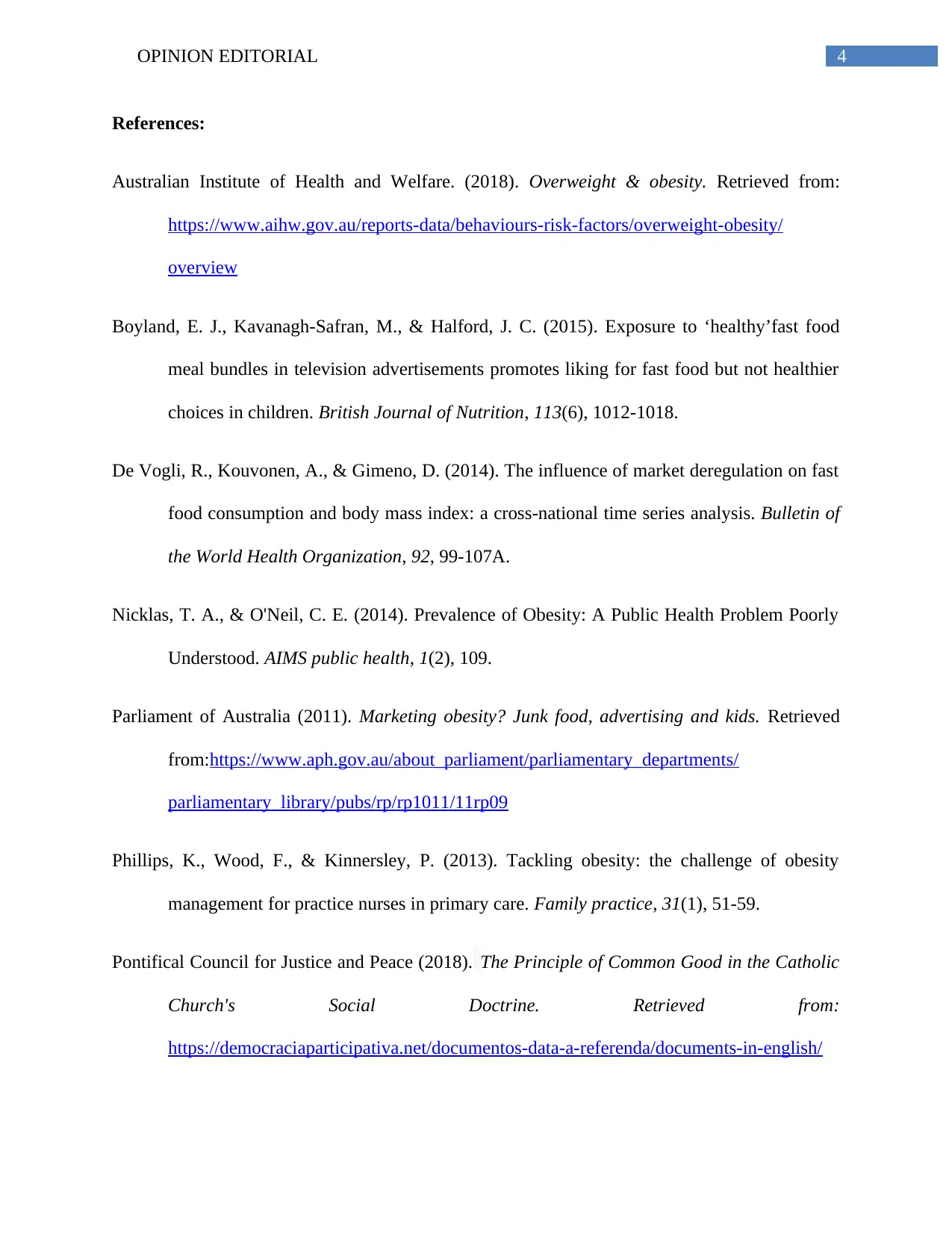
4OPINION EDITORIAL
References:
Australian Institute of Health and Welfare. (2018). Overweight & obesity. Retrieved from:
https://www.aihw.gov.au/reports-data/behaviours-risk-factors/overweight-obesity/
overview
Boyland, E. J., Kavanagh-Safran, M., & Halford, J. C. (2015). Exposure to ‘healthy’fast food
meal bundles in television advertisements promotes liking for fast food but not healthier
choices in children. British Journal of Nutrition, 113(6), 1012-1018.
De Vogli, R., Kouvonen, A., & Gimeno, D. (2014). The influence of market deregulation on fast
food consumption and body mass index: a cross-national time series analysis. Bulletin of
the World Health Organization, 92, 99-107A.
Nicklas, T. A., & O'Neil, C. E. (2014). Prevalence of Obesity: A Public Health Problem Poorly
Understood. AIMS public health, 1(2), 109.
Parliament of Australia (2011). Marketing obesity? Junk food, advertising and kids. Retrieved
from:https://www.aph.gov.au/about_parliament/parliamentary_departments/
parliamentary_library/pubs/rp/rp1011/11rp09
Phillips, K., Wood, F., & Kinnersley, P. (2013). Tackling obesity: the challenge of obesity
management for practice nurses in primary care. Family practice, 31(1), 51-59.
Pontifical Council for Justice and Peace (2018). The Principle of Common Good in the Catholic
Church's Social Doctrine. Retrieved from:
https://democraciaparticipativa.net/documentos-data-a-referenda/documents-in-english/
References:
Australian Institute of Health and Welfare. (2018). Overweight & obesity. Retrieved from:
https://www.aihw.gov.au/reports-data/behaviours-risk-factors/overweight-obesity/
overview
Boyland, E. J., Kavanagh-Safran, M., & Halford, J. C. (2015). Exposure to ‘healthy’fast food
meal bundles in television advertisements promotes liking for fast food but not healthier
choices in children. British Journal of Nutrition, 113(6), 1012-1018.
De Vogli, R., Kouvonen, A., & Gimeno, D. (2014). The influence of market deregulation on fast
food consumption and body mass index: a cross-national time series analysis. Bulletin of
the World Health Organization, 92, 99-107A.
Nicklas, T. A., & O'Neil, C. E. (2014). Prevalence of Obesity: A Public Health Problem Poorly
Understood. AIMS public health, 1(2), 109.
Parliament of Australia (2011). Marketing obesity? Junk food, advertising and kids. Retrieved
from:https://www.aph.gov.au/about_parliament/parliamentary_departments/
parliamentary_library/pubs/rp/rp1011/11rp09
Phillips, K., Wood, F., & Kinnersley, P. (2013). Tackling obesity: the challenge of obesity
management for practice nurses in primary care. Family practice, 31(1), 51-59.
Pontifical Council for Justice and Peace (2018). The Principle of Common Good in the Catholic
Church's Social Doctrine. Retrieved from:
https://democraciaparticipativa.net/documentos-data-a-referenda/documents-in-english/
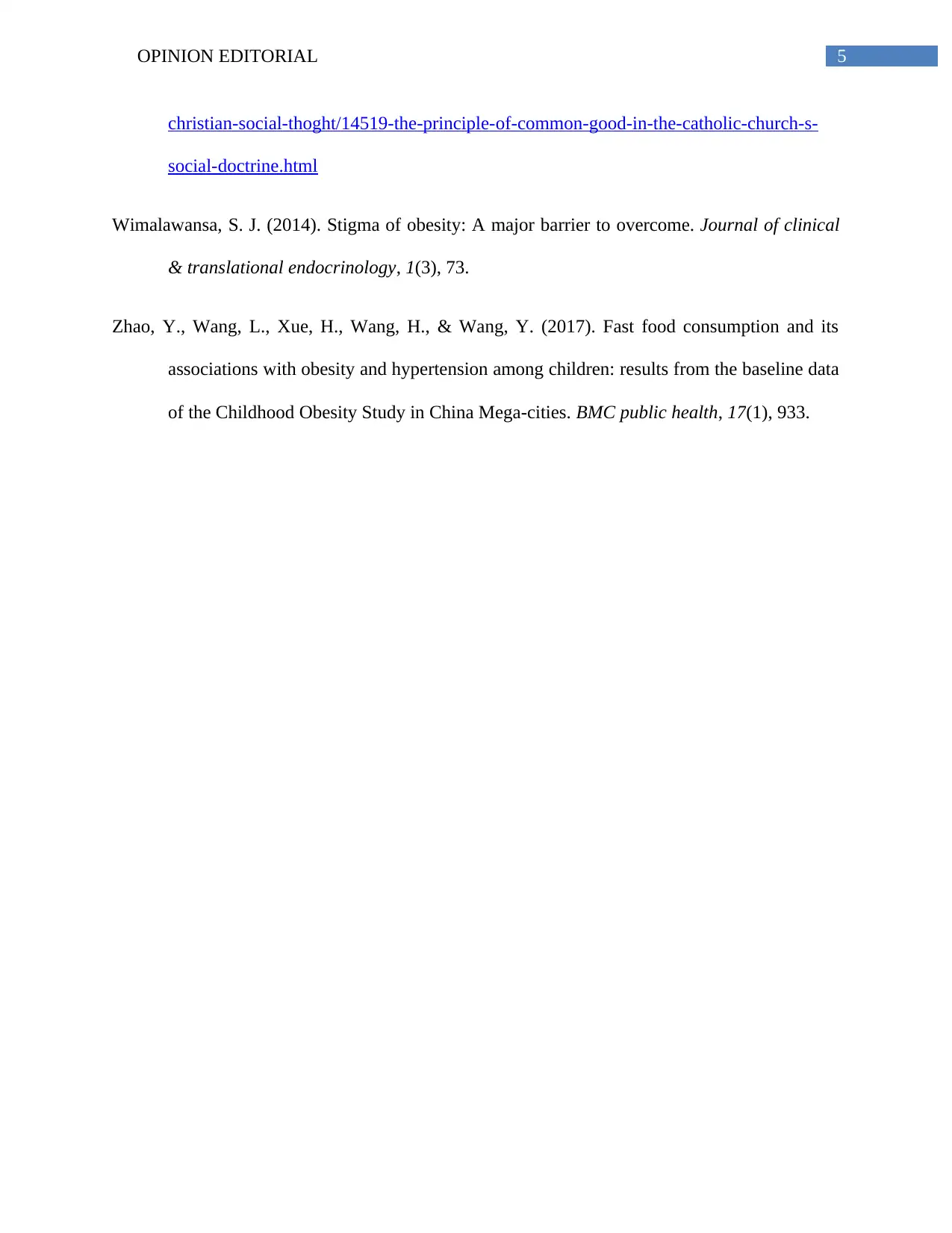
5OPINION EDITORIAL
christian-social-thoght/14519-the-principle-of-common-good-in-the-catholic-church-s-
social-doctrine.html
Wimalawansa, S. J. (2014). Stigma of obesity: A major barrier to overcome. Journal of clinical
& translational endocrinology, 1(3), 73.
Zhao, Y., Wang, L., Xue, H., Wang, H., & Wang, Y. (2017). Fast food consumption and its
associations with obesity and hypertension among children: results from the baseline data
of the Childhood Obesity Study in China Mega-cities. BMC public health, 17(1), 933.
christian-social-thoght/14519-the-principle-of-common-good-in-the-catholic-church-s-
social-doctrine.html
Wimalawansa, S. J. (2014). Stigma of obesity: A major barrier to overcome. Journal of clinical
& translational endocrinology, 1(3), 73.
Zhao, Y., Wang, L., Xue, H., Wang, H., & Wang, Y. (2017). Fast food consumption and its
associations with obesity and hypertension among children: results from the baseline data
of the Childhood Obesity Study in China Mega-cities. BMC public health, 17(1), 933.
⊘ This is a preview!⊘
Do you want full access?
Subscribe today to unlock all pages.

Trusted by 1+ million students worldwide
1 out of 6
Related Documents
Your All-in-One AI-Powered Toolkit for Academic Success.
+13062052269
info@desklib.com
Available 24*7 on WhatsApp / Email
![[object Object]](/_next/static/media/star-bottom.7253800d.svg)
Unlock your academic potential
Copyright © 2020–2025 A2Z Services. All Rights Reserved. Developed and managed by ZUCOL.





